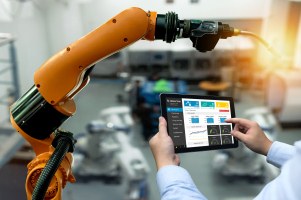Robots versus procrastination

Business owners are always trying to increase productivity in the workplace. They can introduce exercise breaks, have standing meetings and organise team-building days. However, in the manufacturing sector, these initiatives are unlikely to have an impact.
Here, Jonathan Wilkins, marketing director at obsolete industrial parts supplier, EU Automation, explains how automation improves human productivity.
In the manufacturing sector, introducing automation to the assembly line is one way facilities managers can increase production.
Historically, humans have had a strained relationship with technology, fearing it will take their jobs. However,increased automation can do more than take over jobs, it also improves human productivity. This can be by completing the dangerous tasks that humans do or streamlining processes to make human work easier.
Augmented reality
Augmented reality (AR) helps upskill employees by providing necessary information at the touch of a button. For example, data on wearable technology can instruct an employee on how to repair a machine and inform other workers about the maintenance work.
AI and machine learning
Artificial intelligence (AI) can carry out many tasks in consumer applications, from playing chess to taking dinner orders. In industrial applications, AI assists manufacturers with decision making, in everything from maintenance to business strategy.
Some argue that AI will take away human involvement in projects. However, AI is there to support human decisions rather than make the decisions for them. AI will be able to show all of the possible decisions faster than a human to ensure that every possible route is considered.
Cloud computing
It is difficult to keep track of documents, calendars and everything else on computers, especially when there are multiple devices, other people’s computers and software updates to contend with.

Jonathan Wilkins
Cloud computing allows an entire workforce access to the same files. This means that multiple versions of documents don’t have to be created, so everyone knows what is going on and has the ability to collaborate on that work.
As more businesses open international offices, cloud computing allows international collaboration, as one person in Singapore and one in the UK can edit the same document from their own desks. Cloud computing also controls software updates to ensure all technology is up to date, giving human workers time to produce more innovative services and have a cost-effective way of having the latest technology.
With careful consideration, facilities managers can invest in automation to help human workers become more productive. Away days and office activities can be great for team building. However, the best method for drastically increasing productivity in manufacturing is to streamline processes using automation alongside humans.
The author of this blog is Jonathan Wilkins, marketing director at EU Automation
Comment on this article below or via Twitter @IoTGN
